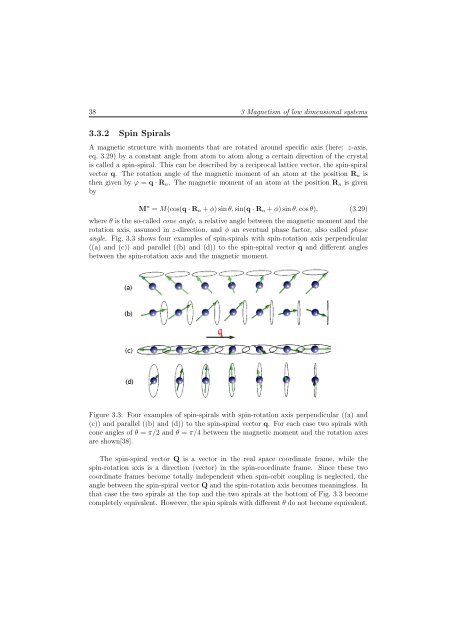Ab initio investigations of magnetic properties of ultrathin transition ...
Ab initio investigations of magnetic properties of ultrathin transition ...
Ab initio investigations of magnetic properties of ultrathin transition ...
Create successful ePaper yourself
Turn your PDF publications into a flip-book with our unique Google optimized e-Paper software.
38 3 Magnetism <strong>of</strong> low dimensional systems<br />
3.3.2 Spin Spirals<br />
A <strong>magnetic</strong> structure with moments that are rotated around specific axis (here: z-axis,<br />
eq. 3.29) by a constant angle from atom to atom along a certain direction <strong>of</strong> the crystal<br />
is called a spin-spiral. This can be described by a reciprocal lattice vector, the spin-spiral<br />
vector q. The rotation angle <strong>of</strong> the <strong>magnetic</strong> moment <strong>of</strong> an atom at the position Rn is<br />
then given by ϕ = q · Rn. The <strong>magnetic</strong> moment <strong>of</strong> an atom at the position Rn is given<br />
by<br />
M n = M(cos(q · Rn + φ) sin θ, sin(q · Rn + φ) sin θ, cos θ), (3.29)<br />
where θ is the so-called cone angle, a relative angle between the <strong>magnetic</strong> moment and the<br />
rotation axis, assumed in z-direction, and φ an eventual phase factor, also called phase<br />
angle. Fig. 3.3 shows four examples <strong>of</strong> spin-spirals with spin-rotation axis perpendicular<br />
((a) and (c)) and parallel ((b) and (d)) to the spin-spiral vector q and different angles<br />
between the spin-rotation axis and the <strong>magnetic</strong> moment.<br />
Figure 3.3: Four examples <strong>of</strong> spin-spirals with spin-rotation axis perpendicular ((a) and<br />
(c)) and parallel ((b) and (d)) to the spin-spiral vector q. For each case two spirals with<br />
cone angles <strong>of</strong> θ = π/2 and θ = π/4 between the <strong>magnetic</strong> moment and the rotation axes<br />
are shown[38].<br />
The spin-spiral vector Q is a vector in the real space coordinate frame, while the<br />
spin-rotation axis is a direction (vector) in the spin-coordinate frame. Since these two<br />
coordinate frames become totally independent when spin-orbit coupling is neglected, the<br />
angle between the spin-spiral vector Q and the spin-rotation axis becomes meaningless. In<br />
that case the two spirals at the top and the two spirals at the bottom <strong>of</strong> Fig. 3.3 become<br />
completely equivalent. However, the spin spirals with different θ do not become equivalent.

















